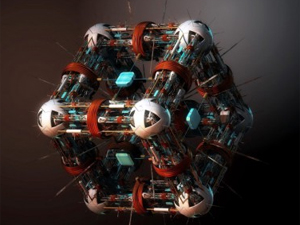



Date:03/11/16
 While the trend for miniaturisation in consumer technology has been halted in recent years with the rise of the 'phablet', the internal components of most of your gadgets are continuing to get smaller.
While the trend for miniaturisation in consumer technology has been halted in recent years with the rise of the 'phablet', the internal components of most of your gadgets are continuing to get smaller.
Now, engineers at the University of California, Santa Barbara, have designed the world's smallest computing device. It uses an unconventional form of logic and measures less than 50 nanometres on each side – about the same size as a biological virus.
“Novel computing paradigms are needed to keep up with the demand for faster, smaller and more energy-efficient devices,” said Gina Adam, who worked on the project.
“In a regular computer, data processing and memory storage are separated, which slows down computation. Processing data directly inside a three-dimensional memory structure would allow more data to be stored and processed much faster.”
That's exactly what the team did. They used an unusual logic system called 'material implication logic', where logic operation and information storage happen simultaneously in the same place, not separated as in most computers. As a result, no space is needed to move data back and forth to the memory.
To be clear, we don't yet have the technology to fabricate a computer this small – but the team's designs mean that all we need now is the engineering capability. Nonetheless, they plan to keep working on it.
“Since this technology is still new, more research is needed to increase its reliability and lifetime and to demonstrate large scale three-dimensional circuits tightly packed in tens or hundreds of layers,” Adam said.
The full details of the computing device were published in the journal Nano Research.
The smallest computer ever is less than 50 nanometres on each side
 While the trend for miniaturisation in consumer technology has been halted in recent years with the rise of the 'phablet', the internal components of most of your gadgets are continuing to get smaller.
While the trend for miniaturisation in consumer technology has been halted in recent years with the rise of the 'phablet', the internal components of most of your gadgets are continuing to get smaller.Now, engineers at the University of California, Santa Barbara, have designed the world's smallest computing device. It uses an unconventional form of logic and measures less than 50 nanometres on each side – about the same size as a biological virus.
“Novel computing paradigms are needed to keep up with the demand for faster, smaller and more energy-efficient devices,” said Gina Adam, who worked on the project.
“In a regular computer, data processing and memory storage are separated, which slows down computation. Processing data directly inside a three-dimensional memory structure would allow more data to be stored and processed much faster.”
That's exactly what the team did. They used an unusual logic system called 'material implication logic', where logic operation and information storage happen simultaneously in the same place, not separated as in most computers. As a result, no space is needed to move data back and forth to the memory.
To be clear, we don't yet have the technology to fabricate a computer this small – but the team's designs mean that all we need now is the engineering capability. Nonetheless, they plan to keep working on it.
“Since this technology is still new, more research is needed to increase its reliability and lifetime and to demonstrate large scale three-dimensional circuits tightly packed in tens or hundreds of layers,” Adam said.
The full details of the computing device were published in the journal Nano Research.
Views: 444
©ictnews.az. All rights reserved.Similar news
- Azerbaijani project to monitor disease via mobile phones
- Innovative educational system to be improved under presidential decree
- NTRC prolongs license of two TV and radio organizations for 6 years
- Azerbaijan establishes e-registry for medicines
- Azerbaijani museum introduces e-guide
- Nar Mobile opens “Nar Dunyasi” sales and service center in Siyazan city
- International conference on custom electronic services held in Baku
- OIC secretary general to attend COMSTECH meeting in Baku
- Azerbaijan develops earthquake warning system
- New law to regulate transition to digital broadcasting in Azerbaijan
- Azerbaijani State Social Protection Fund introduces electronic digital signature
- Intellectual traffic management system in Baku to be commissioned in December
- Tax Ministry of Azerbaijan started receiving video-addresses
- World Bank recommends Azerbaijan to speed up e-service introduction in real estate
- Azerbaijan to shift to electronic registration of real estate





















